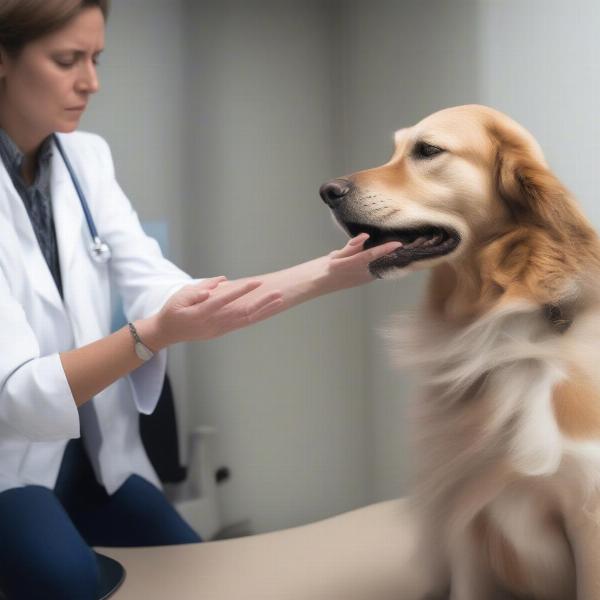Dogs shaking after being petted is a common sight, leaving many owners wondering about the reason behind this seemingly involuntary action. Is it a sign of enjoyment, annoyance, or something else entirely? Understanding this behavior can give you deeper insights into your canine companion’s communication and strengthen your bond.
Decoding the Doggy Shake: Pleasure, Relief, or Something More?
While the doggy shake might seem simple, several factors can contribute to it. One of the most common reasons is simply a way for your dog to reset and relieve tension. Think of it as a full-body stretch after a good cuddle. The petting, while enjoyable, can build up a slight static charge or cause a mild shift in their fur, which they shake off to return to a comfortable state.
Another interpretation is pure pleasure. Just as we might sigh contentedly after a relaxing massage, a dog’s shake can be a physical manifestation of enjoyment and satisfaction. This is especially true if the shake is accompanied by other positive body language like a relaxed posture, wagging tail, and soft panting.
However, a shake can also signal something less positive. If your dog is shaking excessively, particularly after being touched in a specific area, it might be an indication of discomfort or pain. In these cases, pay close attention to their other body language cues like lip licking, yawning, or turning their head away. If you suspect your dog is in pain, consult a veterinarian immediately.
Is it a Breed-Specific Trait?
While all dogs can shake, some breeds might be more prone to it due to their coat type or personality. Dogs with thick, double coats, like Huskies or Retrievers, might shake more frequently to fluff their fur and regulate their body temperature. Similarly, more energetic breeds might shake as a way to release pent-up energy after a calm petting session.
Other Reasons Why Your Dog Might Shake
Beyond petting, several other factors can trigger a dog’s shaking reflex:
- Drying off: A wet dog’s shake is an instinctive way to remove excess water from their fur.
- Relieving stress or anxiety: Dogs might shake after a stressful event, like a loud noise or unfamiliar situation, as a way to calm themselves.
- Getting rid of irritants: If something is bothering their skin, like a bug or a burr, shaking can help dislodge it.
- Medical reasons: In some cases, shaking can be a symptom of an underlying medical condition like allergies, ear infections, or neurological problems.
When to Consult a Veterinarian
While shaking is usually a harmless behavior, it’s important to be aware of potential warning signs. Consult a veterinarian if you notice any of the following:
- Excessive shaking
- Shaking accompanied by other symptoms like lethargy, loss of appetite, or vomiting
- Shaking focused on a specific area of the body
- Sudden onset of shaking without an obvious trigger
 Dog shaking during veterinary visit
Dog shaking during veterinary visit
Conclusion
Understanding why dogs shake after being petted can deepen your understanding of your furry friend. Most often, it’s a harmless and natural behavior indicating pleasure, relaxation, or simply a way to reset. However, by paying attention to the context and accompanying body language, you can differentiate between a happy shake and a sign of potential discomfort. Always consult a veterinarian if you have any concerns about your dog’s health or behavior.
FAQ
- Why does my dog shake after I scratch his belly? Belly rubs can be intensely pleasurable for dogs, and the shake might be a physical expression of that enjoyment, or simply a way to release tension.
- Is it bad to pet a dog while it’s shaking? No, petting a shaking dog isn’t inherently harmful. However, if the shaking is due to fear or anxiety, it’s best to give them space and allow them to calm down.
- Do all dogs shake after being petted? While shaking is common, not all dogs exhibit this behavior after being petted. Individual personality and experiences play a role.
- Can I train my dog to stop shaking? Shaking is a natural reflex, and it’s generally not recommended to try and suppress it.
- Should I be concerned if my old dog starts shaking more frequently? Increased shaking in older dogs could be a sign of age-related issues or underlying health problems, so it’s worth consulting a veterinarian.
- My dog shakes after I put on his harness. Is this normal? This could be due to excitement for a walk or slight discomfort. Ensure the harness fits correctly and isn’t too tight.
- Why does my dog shake after a bath? Shaking is a dog’s natural way to dry off and remove excess water from their fur.
ILM Dog is your trusted resource for all things dog-related. From breed selection and puppy care to senior dog health and training tips, we’re here to help you provide the best possible care for your furry companion. Our expert advice covers nutrition, grooming, behavior, and much more. We also offer insights into the latest pet care trends and veterinary best practices. For any questions or concerns, please contact us at [email protected] or call us at +44 20-3965-8624. Visit ILM Dog for more valuable information and expert guidance.